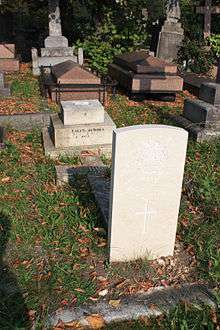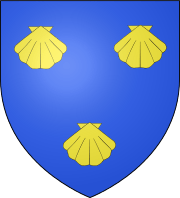Pringle baronets
| Baronetcy of Pringle of Stichill | |
|---|---|
|
Coat of arms of the Pringles of Stichill: Azure, three escallops, or | |
| Creation date | 5 January 1683 |
| Monarch | Charles II |
| Peerage | Baronetage of Nova Scotia |
| First holder | Sir Robert Pringle, 1st Baronet |
| Present holder | Sir Norman Murray Pringle, 10th Baronet |
| Heir apparent | Alastair Steuart Ronald Pringle |
| Remainder to | The male heirs of his [Robert Pringle of Stichill] body |
| Former seat(s) |
Stitchill House, Roxburghshire Undermount, Bonchurch, Isle of Wight |
There have been two baronetcies created for members of the Scottish Pringle family, one in the Baronetage of Nova Scotia and one in the Baronetage of Great Britain. As of 2015, one creation is extant.
The Pringle Baronetcy, of Stichill in the County of Roxburgh, was created in the Baronetage of Nova Scotia on 5 January 1683 for Robert Pringle.[1] The fourth Baronet sat as Member of Parliament for Berwickshire.
The Pringle Baronetcy, of Pall Mall, was created in the Baronetage of Great Britain on 5 June 1766 for the physician John Pringle. He was the youngest son of the second Baronet of the 1673 creation. The title became extinct on his death in 1782.
2013-2016 dispute over lineage
The 10th Baronet was Commandant General Royal Marines from 1981 to 1985. After his death in 2013, the title was claimed by his eldest son, Simon. However, DNA testing, originally gathered to determine who the current clan chief of the Clan Pringle (dormant since 1738) should be, showed that the 10th baronet was not genetically related to the rest of the Pringle clan. Steuart's first cousin (and therefore Simon's first cousin once removed) Norman Murray Pringle (born 3 August 1941) contested the title, on the basis that the 9th baronet should have been his father, Ronald Steuart Pringle (26 April 1905 – 24 July 1968), the younger, legitimate son of the 8th baronet. While the dispute continued, the baronetcy was dormant, due to the conflicting claims of Murray Pringle and Simon Pringle since neither had proven their right of succession to the baronetcy over the other. As a consequence neither was entered on the Official Roll of the Baronetage.[2]
The Queen, acting under the Judicial Committee Act 1833,[3] referred the matter to the Judicial Committee of the Privy Council,[4] which held its hearings on the matter in November 2015[5][6] and January 2016.[1][7]It delivered its ruling on 20 June 2016,[8] determining that DNA evidence[9] proved that Sir Norman Hamilton Pringle, 9th Baronet, was conceived adulterously and was not the son of Sir Norman Robert Pringle, 8th Baronet. As such, on the latter's death, the baronetcy rightfully passed to his first biological son, Ronald Steuart Pringle, and then to his son, Norman Murray Pringle.
In delivering the judgment, Lord Hodge expressed sympathy for the late Steuart Pringle and his son Simon, stating:
| “ |
85. In the past, the absence of scientific evidence meant that the presumption of legitimacy could rarely be rebutted and claims based on assertions that irregular procreations had occurred in the distant past were particularly difficult to establish. Not so now. It is not for the Board to express any view on what social policy should be. It notes the ability of DNA evidence to reopen a family succession many generations into the past. Whether this is a good thing and whether legal measures are needed to protect property transactions in the past, the rights of the perceived beneficiary of a trust of property, and the long established expectations of a family, are questions for others to consider. |
” |
On 27th June 2016 Grant Bavister, Assistant Register to the Baronetage at the Ministry of Justice, entered Sir Ronald Steuart Pringle and his son Sir Norman Murray Pringle onto the Official Roll of the Baronetage, as the 9th and 10th Baronets. He also removed Norman Hamilton Pringle and his son Steuart Robert Pringle from the Roll, in accordance with the Royal Warrant of 1910. Certificates of succession to this effect were issued to Sir Norman Murray Pringle on 1st July 2016.
Pringle baronets, of Stichill (1683)


- Sir Robert Pringle, 1st Baronet (died c. 1700)
- Sir John Pringle, 2nd Baronet (1662–1721)
- Sir Robert Pringle, 3rd Baronet (1690–1779)
- Sir James Pringle, 4th Baronet (1726–1809)
- Sir John Pringle, 5th Baronet (1784–1869)
- Sir Norman Pringle, 6th Baronet (1787–1870)
- Sir Norman William Drummond Pringle, 7th Baronet (1836–1897)
- Sir Norman Robert Pringle, 8th Baronet (1871–1919) - war grave
- Sir Ronald Steuart Pringle, 9th Baronet (1905-1968)
- Sir Norman Murray Archibald MacGregor Pringle, 10th Baronet (1941- )
- heir apparent Alastair Steuart Ronald Pringle (b 1972- )
Relatives who were incorrectly registered as Baronets of Stichill:
- Squadron Leader Norman Hamilton Pringle, False 9th Baronet (1903–1961) - Illegitimate uncle of present Baronet
- Lt-Gen Sir Steuart Robert Pringle KCB, False 10th Baronet (1928–2013) - First cousin of present Baronet.
Pringle baronets, of Pall Mall (1766)
- Sir John Pringle, 1st Baronet (1707–1782)
See also
References
- 1 2 "Docket: In the matter of Baronetcy of Pringle of Stichill". Judicial Committee of the Privy Council. Retrieved 11 October 2015.
- ↑ "Official Roll of the Baronetage". baronetage.org. Retrieved 11 October 2015.
- ↑ UK Parliament. Judicial Committee Act 1833 as amended (see also enacted form), from legislation.gov.uk.
- ↑ Walton, Gregory (11 October 2015). "Queen intervenes to settle title feud opening way to title pretenders". The Daily Telegraph.
- ↑ Beckford, Martin (10 October 2015). "Who's the real aristocrat? Queen demands DNA to be tested in court to settle dispute over 330-year-old baronet title (...but could ruling mean a Utah Mormon is our king?)". The Daily Mail. Retrieved 11 October 2015.
- ↑ "Legal dispute over Pringle of Stichill baronetcy - BBC News". BBC News. 25 November 2015. Retrieved 2016-04-25.
- ↑ "Rival Pringle cousins await verdict in baronetcy wrangle". Herald Scotland. 25 January 2016. Retrieved 2016-04-25.
- ↑ In the matter of the Baronetcy of Pringle of Stichill [2016] UKPC 16 (20 June 2016)
- ↑ Bingham, John (20 June 2016). "Accountant wins legal claim to baronetcy in 'cuckoo in the nest' case that could challenge the British class system". The Daily Telegraph.
Further reading
- Kidd, Charles, Williamson, David (editors). Debrett's Peerage and Baronetage (1990 edition). New York: St Martin's Press, 1990.
